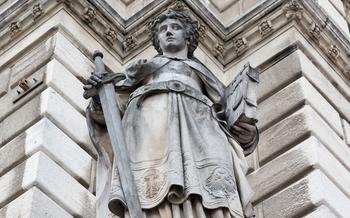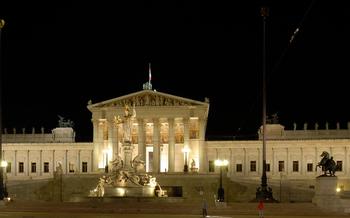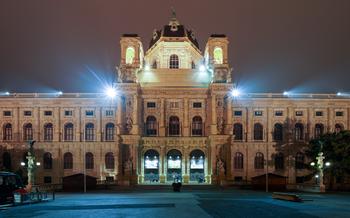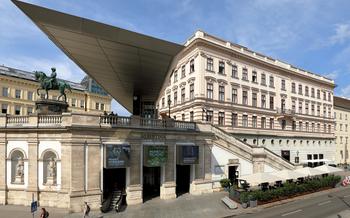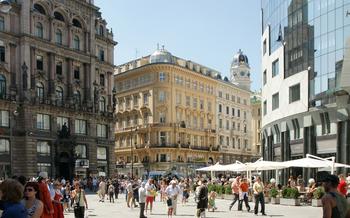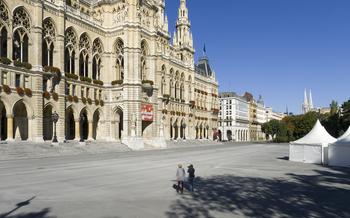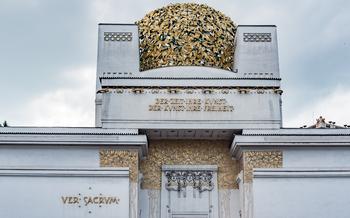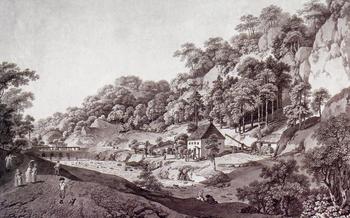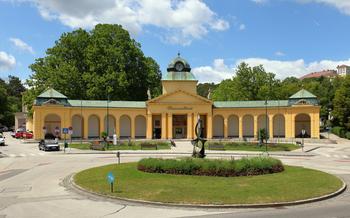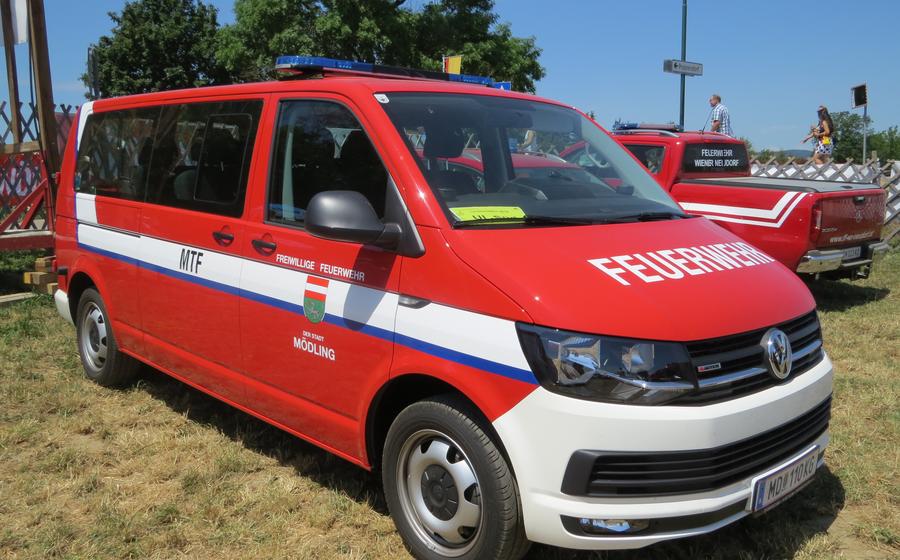
Austrian Parliament Building
- Historical Significance
- Guided Tours
- Exhibitions and Displays
- Rooftop Views
- Visitor Center and Information
- Accessibility and Facilities
- Photography and Videography
- Nearby Attractions
- History of the Parliament
- Dress Code and Etiquette
- Language Options
- Insider Tip: Uncover the Secret Courtyard
Historical Significance
The Austrian Parliament Building, known as the Parlamentsgebäude, stands as a monumental symbol of Austria's democratic journey. Constructed between 1874 and 1883, it has witnessed the shaping of Austria's political landscape, serving as the seat of the Austrian Parliament since its completion. The building's neoclassical architecture, inspired by the Greek Parliament in Athens, exudes an aura of grandeur and authority. Its intricate sculptures and imposing columns reflect the significance it holds in Austrian politics, representing the nation's commitment to democratic principles and the rule of law. Throughout its history, the Parliament Building has hosted pivotal debates, political negotiations, and the passing of landmark laws that have shaped the course of Austria's development. It remains a living testament to the nation's democratic ideals and the unwavering pursuit of progress and prosperity.
Guided Tours
The Austrian Parliament Building offers a variety of guided tours to accommodate visitors' interests and schedules. Regular tours provide a comprehensive overview of the building's history, architecture, and significance in Austrian politics. These tours typically last for about an hour and are available in several languages, including English, German, and French. Visitors can book tickets online or directly at the Parliament visitor center.
Special tours offer a more in-depth exploration of specific aspects of the Parliament Building. For example, there are tours focused on the building's art and architecture, the history of the Austrian Parliament, and the role of women in Austrian politics. These tours are often led by experts in their respective fields and provide a unique opportunity to gain deeper insights into the Parliament's history and significance.
VIP tours offer an exclusive experience for visitors who want to see the Parliament Building beyond the regular tour routes. These tours include access to restricted areas, such as the President's Office and the committee rooms, and provide a personalized encounter with a Parliament staff member. VIP tours must be booked in advance and are subject to availability.
When booking a tour, visitors are advised to make reservations in advance, especially during peak tourist season. Group discounts are available for groups of 10 or more people, and audio guides are provided in several languages for self-guided tours.
Exhibitions and Displays
Within the majestic halls of the Austrian Parliament Building, visitors can embark on a journey through time and discover the rich history, culture, and politics of Austria through a variety of captivating exhibitions and displays. These exhibitions delve into various themes, shedding light on the nation's past, present, and future.
Permanent exhibitions showcase the evolution of Austrian democracy, from its early roots to the establishment of the modern parliamentary system. Visitors can trace the footsteps of influential figures who shaped the nation's political landscape, learn about the challenges and triumphs faced by the Parliament, and gain insights into the inner workings of the legislative process.
Temporary exhibitions, rotating on a regular basis, explore diverse topics related to Austrian politics, society, and culture. These exhibitions often feature interactive displays, multimedia presentations, and thought-provoking installations that engage visitors and encourage them to delve deeper into the issues at hand.
Throughout the Parliament Building, visitors can admire a collection of historical paintings, sculptures, and artifacts that adorn the walls and corridors. These works of art not only add to the building's aesthetic appeal but also provide a glimpse into Austria's rich cultural heritage.
Whether you're a history buff, a political enthusiast, or simply curious about Austrian culture, the exhibitions and displays within the Parliament Building offer a rewarding and enriching experience for visitors of all ages.
Rooftop Views
The Austrian Parliament Building offers visitors the opportunity to soak in breathtaking panoramic views of Vienna from its rooftop terrace. This vantage point provides a unique perspective of the city's iconic landmarks, including the majestic Hofburg Palace, the opulent Rathaus, the meandering Danube River, and the verdant parks that dot the cityscape.
The rooftop terrace is accessible to visitors during guided tours or upon request. It's worth noting that access may be restricted due to weather conditions or special events taking place in the building.
To make the most of your rooftop experience, consider visiting on a clear day to ensure optimal visibility. Capture stunning photographs of Vienna's architectural wonders, with the Parliament Building serving as a majestic backdrop. Take your time to identify and appreciate the city's landmarks, immersing yourself in the beauty and grandeur of Vienna from above.
Visitor Center and Information
The Parliament Building houses a comprehensive visitor center to assist you in making the most of your visit. The center provides a range of services, including ticket sales, information desks, and multilingual brochures. Knowledgeable staff is on hand to answer any questions you may have, offering guidance and recommendations to enhance your experience.
For a deeper understanding of the Parliament's history, politics, and architecture, pick up a guidebook or map at the visitor center. These resources offer insights into the building's significance and help you navigate its many features. Additionally, the center often hosts special events, workshops, and exhibitions related to Austrian history and politics. Check with the staff for details and schedules to make the most of your visit.
Whether you're interested in learning more about the Parliament's inner workings, seeking directions, or simply looking for a souvenir, the visitor center is an invaluable resource. Take advantage of the services and resources offered to make your visit to the Austrian Parliament Building a truly memorable and informative experience.
Accessibility and Facilities
The Austrian Parliament Building is committed to providing a welcoming and accessible environment for all visitors. The building features a range of accessibility features to ensure that everyone can enjoy their visit comfortably and conveniently.
Wheelchair ramps and elevators are strategically placed throughout the building, allowing visitors with mobility challenges to navigate the different floors and spaces with ease. Accessible restrooms are also available, ensuring that everyone has the facilities they need during their visit.
For visitors with hearing impairments, assistive listening devices are available upon request. These devices can be used during guided tours or when attending parliamentary sessions or committee meetings, ensuring that everyone can fully participate and engage with the proceedings.
The Parliament Building also offers a variety of amenities to enhance visitors' experiences. A cloakroom is available for visitors to store their belongings securely while exploring the building. A café is located on the premises, providing refreshments and snacks for those who need a break or want to enjoy a light meal. Visitors can also purchase souvenirs and mementos at the gift shop, taking home a piece of their Parliament experience.
To make the most of the facilities and services available, visitors are encouraged to inquire with the helpful staff at the visitor center. They can provide maps, guides, and recommendations, ensuring that every visitor has a memorable and enjoyable experience at the Austrian Parliament Building.
Photography and Videography
When visiting the Austrian Parliament Building, it's important to be mindful of the rules and regulations regarding photography and videography. While capturing memories of your visit is encouraged, there are certain restrictions and guidelines in place to ensure the privacy and security of the building and its occupants.
Photography and videography are generally permitted in the public areas of the Parliament Building, such as the main entrance hall and the visitor center. However, photography and filming are strictly prohibited in certain areas, such as the Plenary Hall during parliamentary sessions or committee meetings. These areas are clearly marked with signs, and visitors are kindly requested to respect these restrictions.
When taking photos or videos, it's important to be respectful of the privacy of others and avoid capturing images of individuals without their consent. It's also important to avoid using flash photography or tripods, as these can be disruptive to ongoing activities within the building.
If you wish to take photos or videos for commercial purposes or for publication, it's essential to obtain prior permission from the Austrian Parliament. This can be done by contacting the Press and Information Service of the Parliament.
By adhering to these guidelines and respecting the privacy and security of the Parliament Building, you can ensure that your visit is both enjoyable and respectful.
Nearby Attractions
After exploring the grandeur of the Austrian Parliament Building, visitors can venture into the surrounding area to discover a wealth of nearby attractions. A short walk away lies the picturesque Rathauspark, a sprawling green oasis adorned with manicured gardens, tranquil ponds, and towering trees. Take a leisurely stroll along its winding paths, admire the colorful flowerbeds, and soak in the serene atmosphere.
Just across the Ringstraße, visitors will find the Volksgarten, another beautiful park with a rich history. Stroll through its elegant gardens, marvel at the majestic Theseus Temple, and visit the exquisite Rose Garden, home to over 4,000 roses of various colors and fragrances. The park is also home to the Kunsthistorisches Museum and the Naturhistorisches Museum, two world-renowned museums that house priceless collections of art and natural history.
For a cultural immersion, head to the MuseumsQuartier, a vibrant arts and culture complex located a short walk from the Parliament Building. This vibrant district is home to numerous museums, galleries, theaters, and performance spaces, showcasing a diverse range of exhibitions, performances, and events. Explore the Leopold Museum's impressive collection of Austrian art, delve into the fascinating world of music at the Haus der Musik, or catch a captivating performance at the Volkstheater.
These nearby attractions offer a delightful blend of nature, history, art, and culture, ensuring that visitors can create a personalized itinerary that suits their interests and preferences. Whether you seek tranquility in the parks, marvel at artistic masterpieces, or immerse yourself in the vibrant cultural scene, the area surrounding the Austrian Parliament Building has something to offer every visitor.
History of the Parliament
The Austrian Parliament, known as the Nationalrat, has a rich and storied history that dates back to the 19th century. Its origins can be traced to the 1848 Revolutions, which swept across Europe and led to demands for democratic reforms. In Austria, these demands culminated in the creation of a constitutional monarchy and the establishment of a bicameral parliament, consisting of an upper house (the Herrenhaus) and a lower house (the Abgeordnetenhaus). The Abgeordnetenhaus, which was directly elected by the people, served as the main legislative body of the empire.
Over the years, the Austrian Parliament underwent several transformations and changes. In 1918, following the collapse of the Austro-Hungarian Empire, the parliament was reorganized as a unicameral body and renamed the Nationalrat. The interwar period was marked by political instability and the rise of authoritarian regimes, which led to the suspension of parliament in 193
After World War II, the Nationalrat was reestablished and played a crucial role in rebuilding the country's democratic institutions. The 1955 Austrian State Treaty, which restored Austria's independence, guaranteed the country's neutrality and enshrined the principles of democracy and human rights. Since then, the Austrian Parliament has been a cornerstone of the country's stable and prosperous democracy.
Throughout its history, the Austrian Parliament has been the stage for many significant debates and decisions that have shaped the country's political landscape. From the adoption of the Austrian Constitution in 1920 to the recent debates on European integration, the Parliament has been at the heart of Austria's political discourse.
Dress Code and Etiquette
When visiting the Austrian Parliament Building, it is important to dress respectfully and appropriately. While there is no strict dress code, smart casual or business attire is generally recommended. Avoid wearing shorts, tank tops, or excessively revealing clothing. It is also important to be mindful of your behavior while inside the building. Be respectful of the ongoing parliamentary sessions and debates, and avoid causing any disruptions. Refrain from talking loudly, using your mobile phone, or engaging in any disruptive activities. By following these guidelines, you can show your respect for the institution and ensure a pleasant and informative visit.
Language Options
To enhance the visitor experience and cater to a diverse international audience, the Austrian Parliament Building offers a range of language options. Guided tours are conducted in both German and English, ensuring that visitors from different linguistic backgrounds can fully understand the history and significance of the building. In addition, multilingual brochures, information panels, and audio guides are available in multiple languages, including French, Spanish, Italian, and Russian. This commitment to language accessibility allows visitors to immerse themselves in the history and culture of the Parliament, regardless of their native tongue. It is important to note, however, that the official languages of Austria are German and Croatian, and visitors are encouraged to respect this by addressing staff and other visitors in one of these languages whenever possible.
Insider Tip: Uncover the Secret Courtyard
Beyond the grand halls and impressive architecture, the Parliament Building holds a hidden gem – a serene and secluded courtyard nestled in the heart of the complex. Step through a discreet doorway to discover this tranquil oasis, where lush greenery, blooming flowers, and the gentle sound of a fountain create a peaceful retreat. Take a moment to relax and soak in the tranquility of this hidden sanctuary, away from the hustle and bustle of the city. It's the perfect spot to reflect on the history and significance of the Parliament Building or simply enjoy a moment of peace and contemplation.
